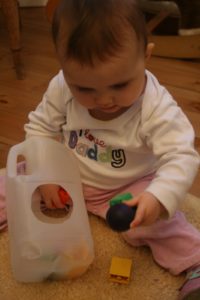Developing Early Reaching Skills to Build Orientation
by Kirstin Peahl
“Early motor development, I believe, is where most of the learned helplessness we see in our older students began,” stated Mickey Demalio, Florida State University Professor. At the Southeast Orientation & Mobility Association (SOMA) 50th Anniversary O&M Conference, Demalio presented information on early childhood motor development and managing behavior that leads to the concept of creating the future adult. Is what we are doing today, moving us closer or further from that person we hope our child will be one day? Are we creating opportunities for our children with visual impairments to gain access to the world around them?
Early motor development includes both gross and fine motor skills. Gross motor skills within the first year of a child’s life include: reflexes, muscle tone, balance, protective reactions, rotation, sitting, scooting, crawling and standing. Fine motor skills within the first year of a child’s life include: awareness and use of hands, grasping, reaching, releasing and crossing midline. According to Ferrel (2011), reaching is the second most important fine motor skill because it leads to control over the environment. She stated that children without disabilities reach visually around 4 or 5 months of age, whereas the median age that PRISM participants (all of whom are visually impaired) reached out to objects (using vision, hearing or touch) was around 8 months. She goes on to state that reaching allows a child’s choices to become greater and the possibilities for decision-making and problem solving are endless. Reaching is a means to interacting with the environment, especially for a child with a visual impairment. Children with vision are much more motivated to interact with the world around them because of incidental experiences that they observe daily. If there is a suspected visual impairment, any member of the Early Intervention team, especially the Developmental Therapist/Vision (DT/V), should make a referral for an Orientation & Mobility evaluation to be completed as soon as possible. Families and professionals working with an infant who has a visual impairment need to work together to create meaningful experiences to provide opportunities for learning the skill of reaching.
Anthony (n.d.) suggests that as children expand their understanding of the space beyond their body and have the physical readiness to move out into space, the reach is extended from an isolated arm to a full body movement. This is the hallmark passage of purposeful movement. Their worldly travels have begun from a mobility perspective. This can be demonstrated in a variety of forms: a roll from back to front, a long stretched reach towards an object of interest, reaching towards sounds, etc. Coinciding with spatial mapping of their body, infants will begin to explore the immediate parameters of the world around them. Toys located on their body and next to their body will be the first ones explored. As children have repeated reinforcement for random movements out into space, they begin to actively search for “what is out there.”
“A child is only as independent as their relatives allow them to be,” Paul Ehresman, COMS, stated as his theory of relativity (Demalio, 2016). Expectations from the families, caregivers and professionals play a role in a child’s gross and fine motor development. Creating opportunities for a child with a visual impairment to reach beyond arm’s length is essential in the motivation for them to explore the world around them. Numerous opportunities for reaching can be integrated into a child’s daily routines. Understanding the development of localizing sound will assist the family in the placement of motivating toys or objects. The developmental placement of sound sources begin at ear level on the side, then moves to below ear level to the side, then moves above ear level to the side and finally in front of the child (Ferrell, 2011). Organizing play areas with defined spatial boundaries will promote object permanence and orientation. With practice, the child will begin to reach for familiar toys or objects. When providing hand under hand guidance, work from behind the child to use a pushing motion when reaching (Lueck, 2008). This will allow the caregiver to model the expected behavior. As the child expands their reaching abilities, the boundaries can be extended beyond arm’s reach (Ferrell, 200l; Lueck, 2008). The materials (both sound-making and silent) for solitary play must motivate children to explore without caregiver assistance (Lueck, 2008). Another opportunity for a caregiver to bond with the child and model expected behavior is to utilize an infant carrier. Carrying your child in a preferred carrier, knapsack, or sling with the child facing forward is a great opportunity for a child with a visual impairment to move through space and begin to explore their environment (Demalio, 2016; Ferrell, 2011).
Creating opportunities for our children with visual impairments to gain access to the world around them is essential for creating that future adult we want our children to become. Orientation & Mobility Specialists and other early intervention professionals need to collaborate with the families to provide strategies to encourage their infant’s development of motor skills and the knowledge of the impact that reaching has on their child’s future independence.
References
Anthony, T. L., Ed.S. (n.d.). Orientation And Mobility (O&M): The Early Years Of Infancy Through Preschool. Retrieved June 20, 2016, from http://www.tsbvi.edu/orientation-a-mobility/3228-orientation-and-mobility-oam-the-early-years-of-infancy-through-preschool
Demalio, M. (2016). Early Childhood Motor Development: Where do Children with Visual Impairment Struggle and How Can We Support the Process of Motor Development.
Ferrell, K. A. (2011). Reach out and teach: Helping your child who is visually impaired learn and grow. New York, NY: AFB Press.
Lueck, A. H. (2008). Developmental guidelines for infants with visual impairment: A guidebook for early intervention. Louisville, KY: American Printing House for the Blind.
